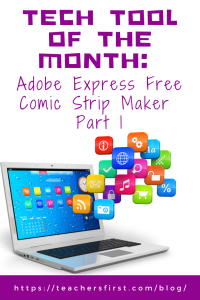Adobe Express Free Comic Strip Maker offers many templates to design, share, and download high-quality comic strips. Quickly search to find the template you wish to use and change color design options, add your text, add images, and then click to download or publish on the web. You can also create several pages of the comic and turn it into a video with a simple button click. You can also assign how many seconds each page is shown during the slideshow. When you finish your comic strip, you can download your completed cartoon to your device as a PNG, PDF, or JPG. You can also share the cartoon strip on social media or click to share the URL. A final feature you will want to take advantage of is the ability to add collaborators.
Applying the Triple E Framework
The Triple E Framework, created by Dr. Liz Kolb, believes that “effective technology integration begins with good instructional strategies and not fancy tools” (tripleeframework.com). Dr. Kolb wrote a book on the topic, Learning First, Technology Second (ISTE, 2017), that lays out the three main uses for technology in education: to Engage, Enhance, or Extend learning goals. We can use this framework to decipher why we use specific classroom tools. Here is a rubric based on the Triple E Framework you can use to evaluate whether Adobe Express Free Comic Strip Maker (or any other technology) is a good fit with your learning goals and whether you should use it in your lesson.
- Engage in learning goals: The students are more focused on the task because they create their own comics at this site. Rather than being passive learners, creating comic strips allows students to become active, social learners. Students are also motivated to begin learning as the numerous templates, images, and other creating options make the tool more engaging.
- Enhance learning goals: Adobe Express Free Comic Strip Maker allows students to demonstrate a more sophisticated understanding of content by creating comic strips rather than just taking a traditional assessment/test. While traditional assessments often have one correct reply, a comic strip allows students to share their knowledge in a more open-ended format. Students can also use this tool to create a path to demonstrate their knowledge in a way they cannot do without technology, as they can virtually share their finished comics.
- Extend learning goals: Dr. Kolb describes extended learning as an opportunity for students to learn, connect, and collaborate outside the regular school day and as a way to create a bridge between school learning and everyday life experiences. Adobe Express Free Comic Strip Maker could be completed as a remote, flipped, or blended learning activity, making this an easy way for students to collaborate outside of the classroom. The site would also make an ideal asynchronous learning experience. Creating comics also bridges school learning and everyday life experiences, as students may have a future profession where storyboarding is used, and creating comics would help kids prepare for this type of thinking.
SAMR Connection
The SAMR Model, by Dr. Ruben Puentedura, suggests that technology implementation has four levels. Therefore, we can use this model as a guideline to analyze how we use technology tools in the classroom. For example, creating a comic using Adobe Express Free Comic Strip Maker can be at the Substitution, Augmentation, and Modification levels, depending on what the student is doing.
- Substitution: The substitution level is the most basic level of SAMR and refers to when technology acts as a direct substitute without any functional improvements. An easy example could be students using Adobe Express Free Comic Strip Maker to create comics rather than writing them on paper and stapling pages together.
- Augmentation: At the level of augmentation, the technology acts as a direct substitute and includes some functional improvements. We could take our comic activity to the level of augmentation by having students use the functional improvements gained from using technology (the comic strip maker) to add images and text, change the layout of their comic, and share the comic privately with their teacher. They could even add the teacher as a collaborator so that the teacher can add notes and comments. Most of these improvements would not be possible without technology.
- Modification: The level of modification allows us to make (or modify) the activity into something more integrated with technology, meaning there is significant task redesign. Using the same comic activity, we could use Adobe Express Free Comic Strip Maker and move to the level of modification by having students collaborate on their comics and share their projects with classmates by adding collaborators, who can edit and comment on the comics.
Take advantage of Part 2 of the Tech Tool of the Month: Adobe Express Free Comic Strip Maker, where we’ll discuss using the tool and classroom ideas. In the meantime, let us know how you have used Adobe Express Free Comic Strip Maker in your education setting in the comment section below.


